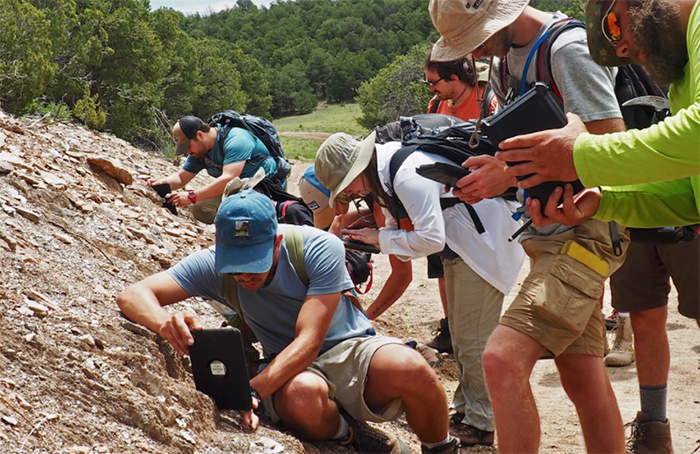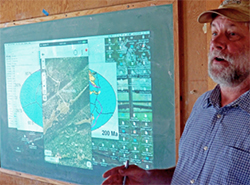KU geologists help spearhead development of app

LAWRENCE — Thanks to the work of geologists at the University of Kansas, all you need starting today to create detailed geologic maps of any region on Earth is a smartphone or a tablet and a desire to understand.
 Led by J. Douglas Walker, the Union Pacific Resources Distinguished Professor of Geology at KU, the group helped plan and conceptualize a new geologic mapping app called the StraboSpot Data System. KU also completed all of the programming and technical development on Strabo. The KU Geology Department tested the app over the last two years in its GEOL 560 and 561 field courses in Colorado.
Led by J. Douglas Walker, the Union Pacific Resources Distinguished Professor of Geology at KU, the group helped plan and conceptualize a new geologic mapping app called the StraboSpot Data System. KU also completed all of the programming and technical development on Strabo. The KU Geology Department tested the app over the last two years in its GEOL 560 and 561 field courses in Colorado.
Version 1.0 of Strabo just became available for download free of charge on iTunes and Google Play. Financed by the National Science Foundation, Strabo is a joint project of KU, the University of Wisconsin, the Arizona Geological Survey and Texas A&M University.
Strabo will have its formal launch in the form of a workshop and separate celebration Oct. 22-26 at the annual meeting of The Geological Society of America in Seattle. The app is named after a Greek geographer, philosopher and historian (63 B.C. - 24 A.D.) who is considered to be the first structural geologist and tectonicist.
"Strabo is an app tailored to field geologists and field students," Walker said. "Behind the scenes, Strabo works more like Facebook than Excel, like other map-making systems such as ArcGIS do. The technology behind Strabo is completely different than the technology we've used before."
Combining a specialized compass with satellite images, mapmaking software, topographic maps, databases and the ability to snap photos to document rock samples, the app has received the enthusiastic endorsement of the students and faculty who tested it. KU Geology master's student Carson Rufledt was among the first class of students to do so.
"Strabo is really a help because one of the biggest issues you have as a student and beginning mapper is trying to find yourself on a map," Rufledt said. "One of the great features of Strabo is that it tells you where you are."
The app also allows geologists to include more data on their maps than they could on paper maps.
"Before you could only make one little line noting a strike and dip (reading showing the orientation of a feature)," Rufledt said. "That's one little piece of information on the map, but with Strabo you can store much more information about each spot on the map."
Strabo can currently accommodate information on structural geology as other mapping systems do. KU has begun work on expanding Strabo to enable it to store data about sedimentology, igneous and metamorphic petrology, and microstructures. In other words, Strabo will soon have the capacity to not only create a drawing of a geologic feature but to also include more detailed data than ever before on the kinds of rocks in each location and the conditions under which they formed and data on the microscale, including electron microprobe images and thin sections of rock.
The co-principal investigators on the Strabo project are Walker, Basil Tikoff at the University of Wisconsin and Julie Newman at Texas A&M. Among the KU faculty, staff and students involved in the creation and testing of Strabo besides Walker are Associate Professor of Geology Andreas Möller; KU programmers Jason Ash and Jessica Novak; Perry Alexander, director of KU's Information & Telecommunication Technology Center; Associate Scientist Diane Kamola; and current and former geology graduate students Emily Bunse, Clay Campbell, Bridget Pettit, Jeff Oalmann, Ty Tenpenny and Rufledt.
Photos: At top, GEOL 560 students use Strabo on iPad minis to take a strike and dip reading during a field exercise in Colorado. At right: J. Douglas Walker, the Union Pacific Resources Distinguished Professor of Geology, lectures on Strabo at the KU Department Field Camp facility outside of Cañon City, Colorado, in June 2017. The rectangle on the board is a projection from Walker's smartphone of one of Strabo's screens.Photos by Diane Silver.